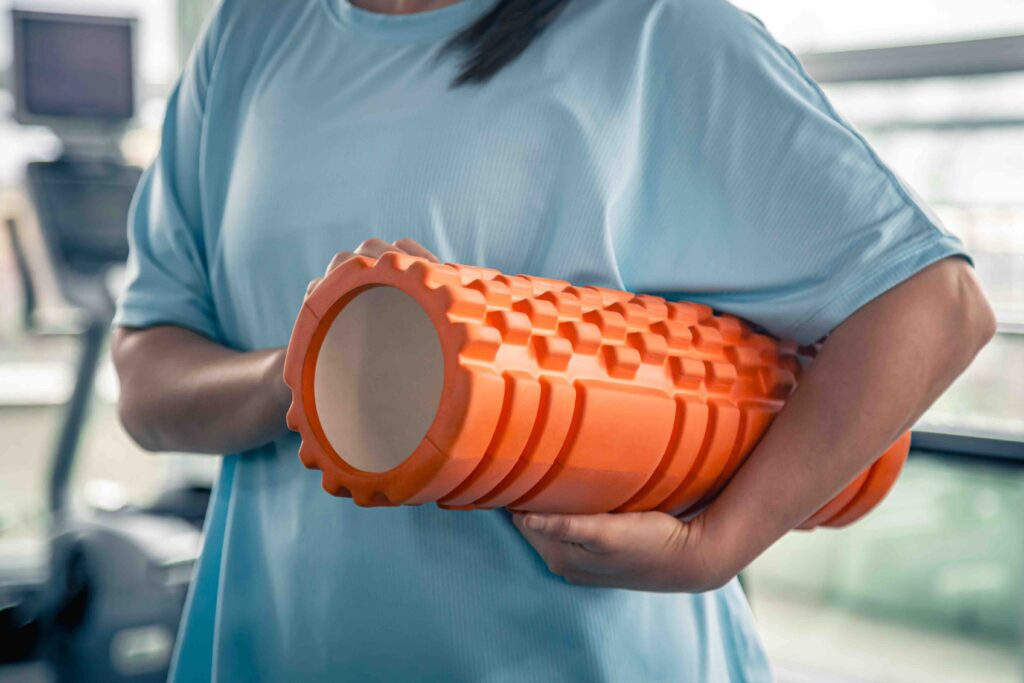Foam rolling can boost mobility and exercise performance as well as peace of mind
Foam rolling is one of those physical activities that, if you like it, you’re on your way to loving it.
The benefits of foam rolling are plentiful: A regular rolling routine not only provides an immediate release from tension and soreness after a grueling workout, but it may also promote mobility, flexibility and overall fitness gains,
Once you figure out proper foam rolling technique — and what level of pressure is right for your muscles — it just feels amazing. (If you find foam rolling uncomfortable, lighten up the intensity, focus on breathing and stick with your practice. It’s about to get so good.)
So, if you’ve got the rolling bug, you may be tempted to do it every day, if not multiple times per day. But when it comes to foam rolling, can you have too much of a good thing?
Here’s what you can expect from making this tension-relieving technique a daily habit.
Your Performance Will Get a Boost
Foam rolling, a form of self-myofascial release, can have a positive effect on your range of motion as well as your overall athleticism, such as speed, agility and strength — but that’s not where its performance advantages end.
Foam rolling helps lay the foundation for optimal athletic performance: In order for a muscle to function (say, twitch, contract or stretch) to the best of its ability, it requires a healthy environment. If it’s surrounded by fibrous scar tissue, which can accumulate as a result of injuries or overuse, it just isn’t going to perform at its peak. Fortunately, foam rolling can help break down that scar tissue to help things work their best. In fact, in a small July 2014 study in the International Journal of Exercise Science, researchers compared the performance benefits of doing a dynamic warm-up versus a dynamic warm-up along with foam rolling. They found that adding foam rolling to the mix improves power, agility, strength and speed better than doing a dynamic warm-up alone.
Every sport will create a different balance or imbalance in how we utilize our body’s muscle groups. The trick is to look for the areas in your body where there is muscle tightness. Foam rolling can help counteract those imbalances, which allows for more fluid, coordinated muscular movement.
Maintaining and caring for those muscular functions are key to a healthy, active life. And you can see the benefits of foam rolling whether you roll for five minutes once a day or for five minutes four times a day, he says. Either way, consistency is key.
Your Flexibility Will Improve
Regular foam rolling can improve muscle flexibility in people with even the tightest, most rigid and knotted muscles. Rolling helps reduce muscle tension, keeping the muscles more pliant and, ultimately, more flexible.
Research backs this up: In a November 2015 systematic review published in The International Journal of Sports Physical Therapy, researchers found that foam rolling significantly improves people’s scores at the sit-and-reach flexibility test. Researchers explain that’s because rolling stimulates blood flow to the body’s muscles while breaking down tight scar tissue, encouraging a greater range of motion in the process.
For the greatest effects, it has been suggested that foam rolling is done prior to exercising (in order to promote blood flow to targeted muscle groups), then doing a combination of stretching and foam rolling during recovery sessions. But integrating the practice into your regular routine is a must if you hope to see sustained results.
Consistency is the key. Occasional rolling will minimize the benefits. Foam rolling regularly will compound your sense of flexibility and lead to less muscular tightness and imbalance.
Your Muscles May Recover Faster
Foam rolling can be thought of as self-massage in the sense that it can speed up the body’s recovery after strenuous activity. By applying pressure and friction to the muscles that were engaged in intense exercise, foam rolling breaks up knots and reduces stiffness, he explains.
For example, a small January 2015 study in the Journal of Athletic Training found that foam rolling helps reduce delayed-onset muscle soreness (DOMS), the pain, tightness and loss of muscle strength that can occur in the days after an especially difficult workout. We have also found using a post-exercise protein supplement within an hour of exercise cessation call also decrease DOMS.
Again, foam rolling promotes blood flow, which helps your body process chemical byproducts of exercising. These byproducts build up within the muscle, they can create a caustic environment, which can manifest as soreness.
Metabolic byproducts aren’t the only contributor but this is why those who foam roll will likely experience less DOMS than those who don’t.
All of this amounts to feeling less worn out and achy in the wake of your workout, providing you make foam rolling a fixture in your everyday cool-down routine.
If you’re battling an acute injury or are living with conditions such as osteoporosis, rheumatoid arthritis or thrombosis, talk to your physical therapist or doctor before starting foam rolling.
Your Stress Levels Might Decrease
Aside from the athletic benefits of foam rolling on a regular basis, it may help reduce stress and counter act the awkward ergonomics we encounter at the workplace.
Many people tend to hold tension in the neck, shoulders and upper back, which can compound already subpar posture. It’s important to have something in your wellness routine that mitigates this stress and the discomfort that comes with it.
Foam rolling, given its cumulative effect on stiffness, soreness and mobility issues, is a great option to alleviate those unpleasant feelings,
Direct pressure, the kind that you experience while foam rolling, has been shown to stimulate the release of positive brain chemicals like dopamine, serotonin and endorphins. These chemicals, in combination with the slow, deep breathing during self-myofascial release, can activate the parasympathetic nervous system, according to the National Academy of Sports Medicine (NASM). As a result, heart rate slows, hormones calm and the body’s stress levels lighten.
Between this direct mind-body effect and the fact that really any sort of soothing, steady routine can cultivate a sense of peace and alleviate anxiety, it stands to reason that your everyday stress levels could benefit from daily foam rolling, too.
Bottom Line: Foam Roll to suit your body’s needs
In short, foam rolling daily is safe, and for people who exercise regularly, it is probably a good idea
With that in mind, your exact routine will depend on your individual physiological needs: Do you want to use foam rolling as a preparatory tool or as a recovery method? Do you want to alleviate tightness or do you want to see long-term improvements to your flexibility?
Ultimately, it’s always better to listen to your body than it is to adhere to a rigid schedule. If foam rolling is creating more soreness, more pain and more stiffness then reduce your time and intensity of rolling. Also, remember that rolling over an injury is not the same and you should be well on your way to healing before resuming regular foam rolling.
So, if you’ve made a daily habit of foam rolling, by all means, keep it up — just watch out for pain points.
References
- The International Journal of Sports Physical Therapy: “The Effects of Self-Myofascial Release Using a Foam Roll or Roller Massager on Joint Range of Motion, Muscle Recovery, and Performance: A Systematic Review”
- International Journal of Exercise Science: “An Acute Bout of Self-Myofascial Release in the Form of Foam Rolling Improves Performance Testing”
- Journal of Athletic Training: “Foam Rolling for Delayed-Onset Muscle Soreness and Recovery of Dynamic Performance Measures”
- National Academy of Sports Medicine: “What Do Foam Rollers Do?”



